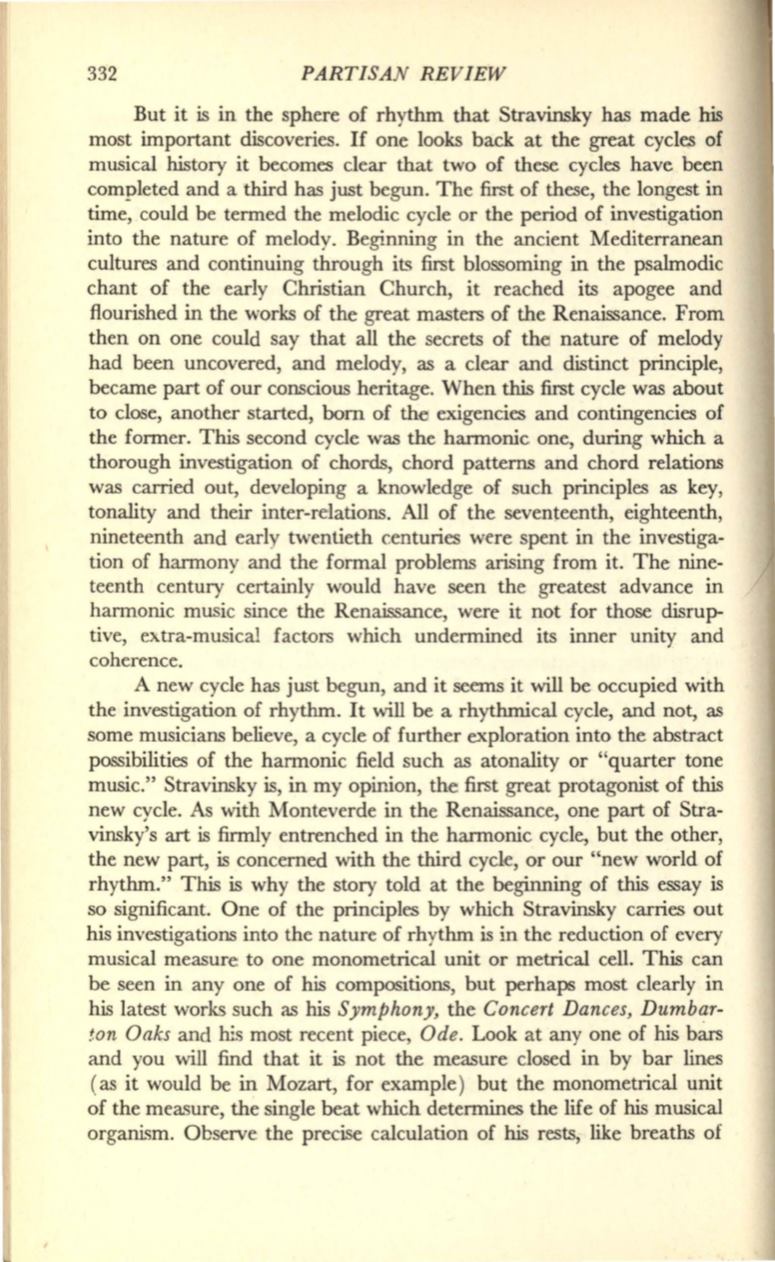
332
PARTISAN REVIEW
But it is in the sphere of rhythm that Stravinsky has made his
most important discoveries.
If
one looks back at the great cycles of
musical history it becomes clear that two of these cycles have been
completed and a third has just begun. The first of these, the longest in
time, could be termed the melodic cycle or the period of investigation
into the nature of melody. Beginning in the ancient Mediterranean
cultures and continuing through its first blossoming in the psalmodic
chant of the early Christian Church, it reached its apogee and
flourished in the works of the great masters of the Renaissance. From
then on one could say that all the secrets of the nature of melody
had been uncovered, and melody, as a clear and distinct principle,
became part of our conscious heritage. When
this
first cycle was about
to close, another started, born of the exigencies and contingencies of
the former. This second cycle was the harmonic one, during which a
thorough investigation of chords, chord patterns and chord relations
was carried out, developing a knowledge of such principles as key,
tonality and their inter-rdations. All of the seventeenth, eighteenth,
nineteenth and early twentieth centuries were spent in the investiga–
tion of harmony and the formal problems arising from it. The nine–
teenth century certainly would have seen the greatest advance in
harmonic music since the Renaissance, were it not for those disrup–
tive, extra-musical fact.ors which undermined its inner unity and
coherence.
A new cycle has just begun, and it seems it will be occupied with
the investigation of rhythm. It will be a rhythmical cycle, and not, as
some musicians believe, a cycle of further exploration into the abstract
possibilities of the harmonic field such as atonality or "quarter tone
music." Stravinsky is, in my opinion, the first great protagonist of
this
new cycle. As with Monteverde in the Renaissance, one part of Stra–
vinsky's art is firmly entrenched in the harmonic cycle, but the other,
the new part, is concerned with the third cycle, or our "new world of
rhythm." This is why the story told at the beginning of
this
essay
is
so significant. One of the principles by which Stravinsky carries out
his investigations into the nature of rhythm is in the reduction of every
musical measure to one manometrical unit or metrical cell. This can
be seen in any one of his compositions, but perhaps most clearly in
his latest works such as his
Symphony,
the
Concert Dances, Dumbar–
!.on Oaks
and his most recent piece,
Ode.
Look at any one of his bars
and you will find that it is not the measure closed in by bar lines
(as it would be
in
Mozart, for example) but the manometrical unit
of the measure, the single beat which determines the life of his musical
organism. Observe the precise calculation of his rests, like breaths of


